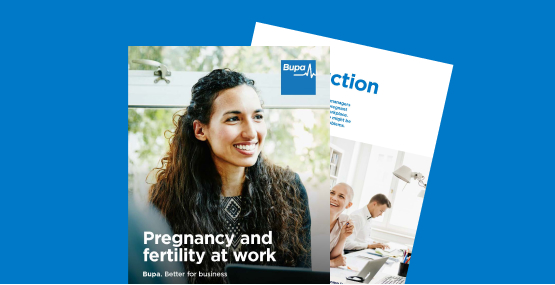Creating a family-friendly workplace
Family-friendly policies are not only good for employees, they are also good for business and the wider economy. It’s estimated that the pro-parenting policies introduced by Nordic countries over the past 50 years have boosted gross domestic product (GDP) by 10 to 20% per capita.1
And the World Bank says,
“Instituting family-friendly measures such as flexible hours, remote work and childcare solutions can reduce staff turnover, improve productivity, and help to attract investment, alongside many other benefits.”2
Culture shift

Rosie Leverton, Head of Corporate Partnerships at Tommy’s, says,
“It takes more than just excellent policies to create a cultural shift in the workplace. But that’s what is needed to deliver meaningful support for individuals.
“A truly family-friendly approach should begin in your recruitment and onboarding processes and seep through into everything you do. It’s about fostering an environment where employees feel comfortable talking to you about their plans to start their family and what support they need. Without feeling like they’ll be judged or penalised.
“Policies should focus on inclusion and support for all parents. Ensuring ongoing open conversations and flexibility, rather than a one size fits all approach."
Motherhood wage penalty
However, women who take the primary role in childcare may experience financial and career penalties as a result. This is sometimes known as the ‘motherhood wage penalty'.
A recent study estimated that British women who are mothers reduce their life-time earnings by 45% compared to women who decide not to, or are unable to, have children.3
On average, women take 10 years out from their careers for child-rearing and lose £39,000 in pension savings.4
Need for support
Research by the Fawcett Society and Totaljobs — which captured insights from 3,000 working parents with children aged four and under, 500 HR decision makers, and 1,254 working adults details an alarming lack of support:5
84% of mothers report challenges returning to work after maternity leave,
30% receive no support when returning,
85% of mothers struggle to find a role that accommodates their childcare needs,
A fifth (19%) have considered quitting due to lack of support for parents and 11% have done so.
It also found that 72% of mothers, and 66% of all employees, said employers who offer family-friendly benefits are more attractive than those who don’t. Yet three-quarters (74%) of HR leaders admit they struggle to provide the right support for working mothers.
Five-point plan
The Fawcett Society suggests a five-point plan.5 It focuses on returning mothers, but will deliver family-friendly policies which benefit all parents:
1
Foster a positive and inclusive culture which shows your organisation understands the challenges facing all parents in the workplace.
2
Create clear policies which encourage parents and their line-managers to understand each other’s expectations, signpost the support that is available and explore how your organisation can embed an effective maternity policy.
3
Upskill managers so they are able to actively listen to the needs of women and working parents and find out how they would prefer to receive support and feedback.
4
Support paternity leave and investigate how to promote effective paternity practices and policies. Encourage men, particularly senior managers, to lead by example and take the statutory paternity leave to which they are entitled.
5
Embed flexible working options such as term-time only, part-time, job-sharing, and compressed hours to find arrangements that work for your teams and your business.
Empower line managers
Rosie says,
“Line managers are key to an employee’s pregnancy and parenting journey in the workplace. It’s essential they are equipped to initiate open conversations, recognise when someone is struggling and able to signpost effective support.”
“It is a tall order to expect line managers to intuitively know what to do. So it’s your responsibility as their employer to ensure they feel supported in having these complex conversations.”
“Some parents working remotely may find it difficult to balance their workload with parenting responsibilities. A return to the workplace might trigger separation anxiety or worries around childcare.”
”Women may also be dealing with physical health problems such as pelvic girdle pain, back ache, incontinence, or breastfeeding issues, such as the need to express and store milk during work hours.”
Structured transition
A structured transition plan for returning colleagues might include mentoring opportunities, refresher training, signposting employee assistance programmes and flexible working, as well as advice around finances and pensions.
Other strategies to consider are establishing, or signposting, peer-to-peer support groups, childcare assistance and encouraging managers to lead by example and encourage clear boundaries between work and home life.
Rosie concludes,
“Recognising that each employee’s situation is different, and exploring ways to accommodate their needs, will also demonstrate that you care about your employee as a person and that you want to provide the best possible support.”
Resources from the Workplace Health and Wellbeing Academy

Manager’s guide: Pregnancy and fertility at work

Manager’s guide: Supporting parents returning to work
1 Unicef
2 Mitwally,Tala Husam Hani; Mohamed,Yasmin Galal Mostafa; Ossaily,Yasmine, The Business Case for Investing in Women’s Employment in Jordan : Amin Kawar and Sons (AKS), The World Bank Group.
3 Giacomo Vagni, Richard Breen, Earnings and Income Penalties for Motherhood: Estimates for British Women Using the Individual Synthetic Control Method, European Sociological Review, Volume 37, Issue 5, October 2021, Pages 834–848, DOI:10.1093/esr/jcab014
4 Institude and Faculty of Actuaries (PDF, 5.5MB), NOW:Pensions, March 2024.
5 Totaljobs, November 2023.


